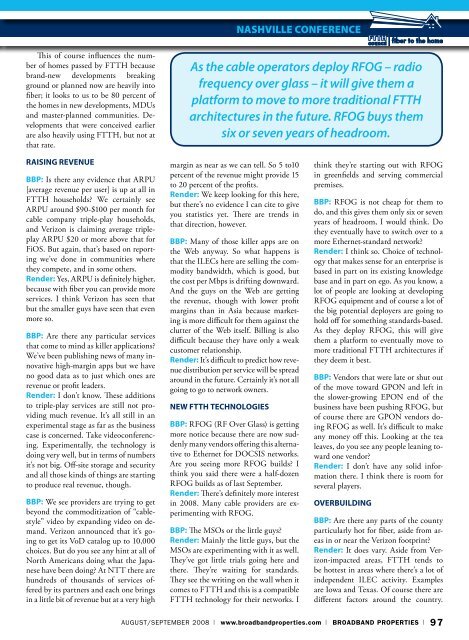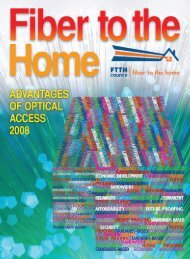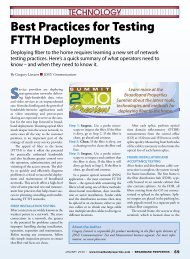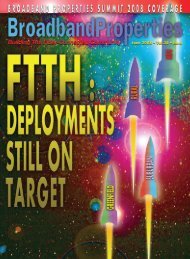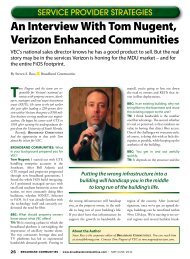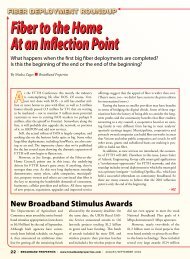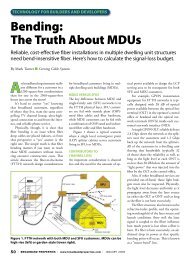FTTH NASHVILLE COVERAGE AT A GLANCE - Broadband Properties
FTTH NASHVILLE COVERAGE AT A GLANCE - Broadband Properties
FTTH NASHVILLE COVERAGE AT A GLANCE - Broadband Properties
Create successful ePaper yourself
Turn your PDF publications into a flip-book with our unique Google optimized e-Paper software.
Nashville conference<br />
This of course influences the number<br />
of homes passed by <strong>FTTH</strong> because<br />
brand-new developments breaking<br />
ground or planned now are heavily into<br />
fiber; it looks to us to be 80 percent of<br />
the homes in new developments, MDUs<br />
and master-planned communities. Developments<br />
that were conceived earlier<br />
are also heavily using <strong>FTTH</strong>, but not at<br />
that rate.<br />
As the cable operators deploy RFOG – radio<br />
frequency over glass – it will give them a<br />
platform to move to more traditional <strong>FTTH</strong><br />
architectures in the future. RFOG buys them<br />
six or seven years of headroom.<br />
Raising Revenue<br />
BBP: Is there any evidence that ARPU<br />
[average revenue per user] is up at all in<br />
<strong>FTTH</strong> households We certainly see<br />
ARPU around $90-$100 per month for<br />
cable company triple-play households,<br />
and Verizon is claiming average tripleplay<br />
ARPU $20 or more above that for<br />
FiOS. But again, that’s based on reporting<br />
we’ve done in communities where<br />
they compete, and in some others.<br />
Render: Yes, ARPU is definitely higher,<br />
because with fiber you can provide more<br />
services. I think Verizon has seen that<br />
but the smaller guys have seen that even<br />
more so.<br />
BBP: Are there any particular services<br />
that come to mind as killer applications<br />
We’ve been publishing news of many innovative<br />
high-margin apps but we have<br />
no good data as to just which ones are<br />
revenue or profit leaders.<br />
Render: I don’t know. These additions<br />
to triple-play services are still not providing<br />
much revenue. It’s all still in an<br />
experimental stage as far as the business<br />
case is concerned. Take videoconferencing.<br />
Experimentally, the technology is<br />
doing very well, but in terms of numbers<br />
it’s not big. Off-site storage and security<br />
and all those kinds of things are starting<br />
to produce real revenue, though.<br />
BBP: We see providers are trying to get<br />
beyond the commoditization of “cablestyle”<br />
video by expanding video on demand.<br />
Verizon announced that it’s going<br />
to get its VoD catalog up to 10,000<br />
choices. But do you see any hint at all of<br />
North Americans doing what the Japanese<br />
have been doing At NTT there are<br />
hundreds of thousands of services offered<br />
by its partners and each one brings<br />
in a little bit of revenue but at a very high<br />
margin as near as we can tell. So 5 to10<br />
percent of the revenue might provide 15<br />
to 20 percent of the profits.<br />
Render: We keep looking for this here,<br />
but there’s no evidence I can cite to give<br />
you statistics yet. There are trends in<br />
that direction, however.<br />
BBP: Many of those killer apps are on<br />
the Web anyway. So what happens is<br />
that the ILECs here are selling the commodity<br />
bandwidth, which is good, but<br />
the cost per Mbps is drifting downward.<br />
And the guys on the Web are getting<br />
the revenue, though with lower profit<br />
margins than in Asia because marketing<br />
is more difficult for them against the<br />
clutter of the Web itself. Billing is also<br />
difficult because they have only a weak<br />
customer relationship.<br />
Render: It’s difficult to predict how revenue<br />
distribution per service will be spread<br />
around in the future. Certainly it’s not all<br />
going to go to network owners.<br />
New <strong>FTTH</strong> Technologies<br />
BBP: RFOG (RF Over Glass) is getting<br />
more notice because there are now suddenly<br />
many vendors offering this alternative<br />
to Ethernet for DOCSIS networks.<br />
Are you seeing more RFOG builds I<br />
think you said there were a half-dozen<br />
RFOG builds as of last September.<br />
Render: There’s definitely more interest<br />
in 2008. Many cable providers are experimenting<br />
with RFOG.<br />
BBP: The MSOs or the little guys<br />
Render: Mainly the little guys, but the<br />
MSOs are experimenting with it as well.<br />
They’ve got little trials going here and<br />
there. They’re waiting for standards.<br />
They see the writing on the wall when it<br />
comes to <strong>FTTH</strong> and this is a compatible<br />
<strong>FTTH</strong> technology for their networks. I<br />
think they’re starting out with RFOG<br />
in greenfields and serving commercial<br />
premises.<br />
BBP: RFOG is not cheap for them to<br />
do, and this gives them only six or seven<br />
years of headroom, I would think. Do<br />
they eventually have to switch over to a<br />
more Ethernet-standard network<br />
Render: I think so. Choice of technology<br />
that makes sense for an enterprise is<br />
based in part on its existing knowledge<br />
base and in part on ego. As you know, a<br />
lot of people are looking at developing<br />
RFOG equipment and of course a lot of<br />
the big potential deployers are going to<br />
hold off for something standards-based.<br />
As they deploy RFOG, this will give<br />
them a platform to eventually move to<br />
more traditional <strong>FTTH</strong> architectures if<br />
they deem it best.<br />
BBP: Vendors that were late or shut out<br />
of the move toward GPON and left in<br />
the slower-growing EPON end of the<br />
business have been pushing RFOG, but<br />
of course there are GPON vendors doing<br />
RFOG as well. It’s difficult to make<br />
any money off this. Looking at the tea<br />
leaves, do you see any people leaning toward<br />
one vendor<br />
Render: I don’t have any solid information<br />
there. I think there is room for<br />
several players.<br />
Overbuilding<br />
BBP: Are there any parts of the county<br />
particularly hot for fiber, aside from areas<br />
in or near the Verizon footprint<br />
Render: It does vary. Aside from Verizon-impacted<br />
areas, <strong>FTTH</strong> tends to<br />
be hottest in areas where there’s a lot of<br />
independent ILEC activity. Examples<br />
are Iowa and Texas. Of course there are<br />
different factors around the country.<br />
August/September 2008 | www.broadbandproperties.com | BROADBAND PROPERTIES | 97


